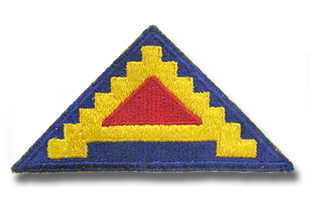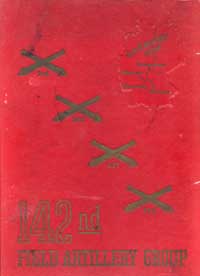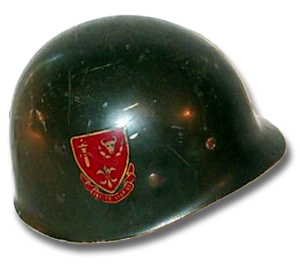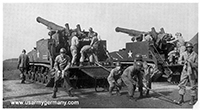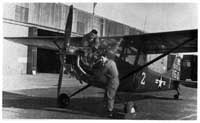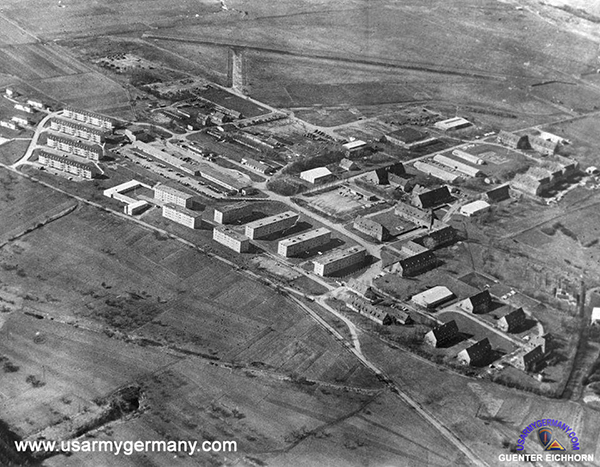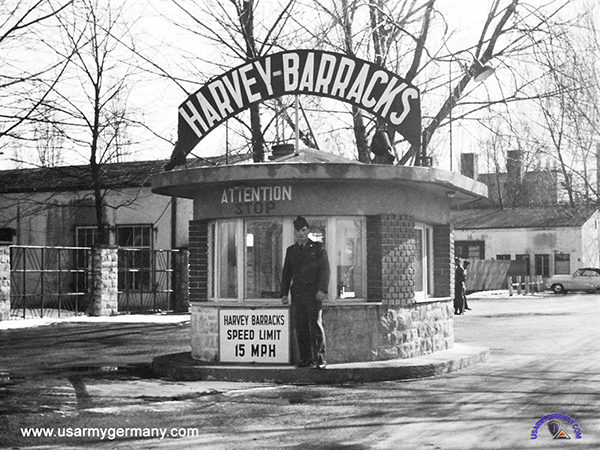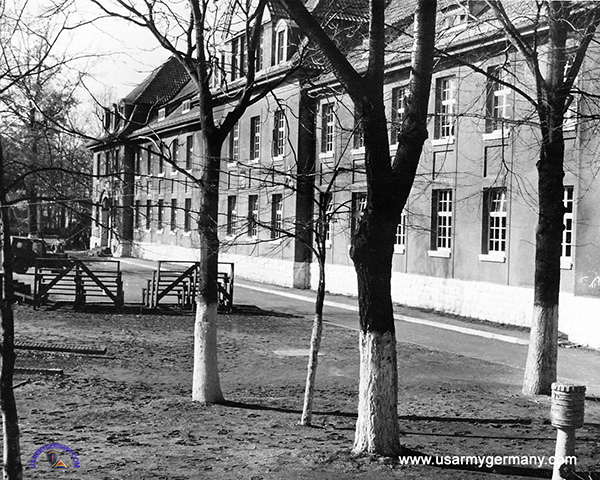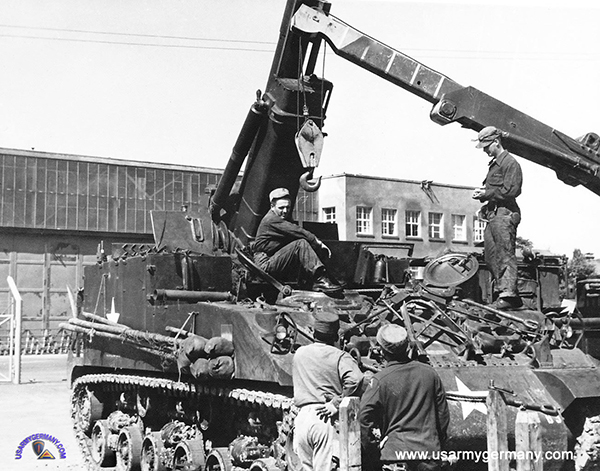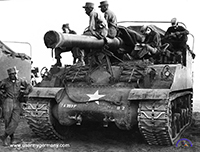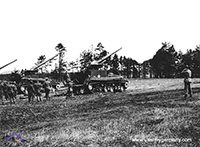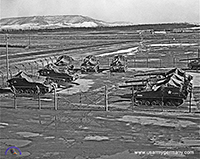| If you do
NOT see the Table of Contents frame to the left of this page, then Click here to open 'USArmyGermany' frameset |
|||||||
142nd Field Artillery Group |
|||||||
|
|
|||||||
|
|||||||

|
|||||||
|
|
|||||||
| Group History | |||||||
| 1951 - 1954 | |||||||
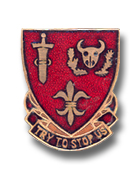 142nd Field Artillery Group DUI
142nd Field Artillery Group DUI(Source: Image of unit crest submitted by Clyde Titus who states: "This unit badge was in use during my time in the 142nd from Mar 1952 to Mar 1954.") |
|||||||
| (Source: 142nd Field Artillery Group, Germany, 1954) | |||||||
|
|||||||
|
|||||||
| If you have more
information on the history or organization of the 142nd FA Group (or
any of the subordinate units), please contact me |
|||||||
|
|
|||||||
| 1952 | |||||||
| (Sources: Email from Clyde Titus, 142nd Field Artillery Group, Germany, 1952-54) | |||||||
| I was stationed
with the 142nd FA Group from August or September of 1952 until March
of 1954 in the S-3 Operations Section of Group headquarters. Trained
in Fire Direction Control, I did clerk-typist duties in camp since
I had two years of college and had better correspondence skills than
the trained clerk-typists. In the field I was assigned a REO two and
half ton truck with trailer holding all of our explosives plus plotting
gear and I worked in the REO built closed van (blackout capable) where
operations were conducted. In 1952 I was still using a WWII GMC 6x6 van at Baumholder (really hard to steer and shift), but that equipment was replaced by REO trucks throughout group headquarters. (REO's had standard transmissions as opposed to the more common and more streamlined GMC's which had automatic transmissions. The REO was a good truck, except it did not like to back up and the gears would wind up and eventually relieve the back lash with a very loud bang.) The Group radio van housed an AN/GRC-9 I believe. |
|||||||
|
|||||||
| We were always attached to the V Corps and always had four battalions in the Group as far as I can remember. The 465th, 594th, 756th, and 816th all seem the correct designations. The Battalion that shared a motor pool with the 142nd at Peden was the 756th Battalion. That unit had 8 inch self-propelled M43 howitzers. I believe the 465th and 816th were also both stationed at Peden Barracks and had 155 mm towed howitzers. The 594th was stationed elsewhere and I think they had 155 mm towed guns. There were not very many M43's made, but a private military vehicle museum in East Los Angeles does have one. The 8-inch self-propelled units were left over from WWII and about three of six could make it to the field at any one time it seems. |
|||||||
|
|||||||
| Another interesting activity was the survey conducted in preparation for the 280 mm "Atomic Annie" artillery. Small teams of top security clearance staff from our Group headquarters went around the countryside in West Germany to determine which roads and bridges could handle this massive equipment. My recollection is that most of the routes would not be available because of the size and weight requirements of the 280. This equipment arrived sometime after I departed in March 1954. Wertheim was a really interesting location, with the little walled-medieval era village and a castle on the hill overlooking the river. It is now a tourist attraction and is called the "little Heidelberg". I returned once in 1989 at the time of the fall of the Berlin Wall but could not get into the barracks area, since the cold war was still on. The 142nd Group insignia was a red shield with a cow skull and the motto "Try to Stop Us". I will prepare a sketch of it and forward it to you when I get the time. Our shoulder patch was the 7th Army patch (without the unauthorized "Seven Steps to Hell" motto). |
|||||||
| (Sources: Email from Keith D. Reichert, 142nd Field Artillery Group, Germany, 1952-54) | |||||||
| 142nd Field Artillery Group - Wertheim, Germany 1952-1954
It was a great surprise to read about the 142nd Field Artillery Group, written by Clyde Titus. I remember Clyde well and would appreciate any help in making contact with him. My mind, at age 85, says he was from Illinois, Champlain comes to mind. My contact with the 142nd started the last week in December, 1952 to May of 1954. After landing at Bremerhaven, I was put on a train to Baumholder with 11 newly arrived replacements, all from southern States, myself coming from Idaho. We were all Field Wiremen trained after basic training, mine at Ft Riley, Kansas. After three days at Baumholder, the 12 of us along with six NCOs and one Lt. were headed for Wertheim, Germany. Our purpose, unknown to us, was to open what had been a small Luftwaffe base, located about one mile above the beautiful village of Wertheim. This was to be the new location of the 142nd Field Artillery Group. During the 18 months I was stationed there, the name Peden Barracks (1) was never used or mentioned. Our advanced detail spent two weeks traveling between Wertheim and Wurtzburg, about 25 miles, transporting equipment and supplies to house the soon to arrive 142nd from Baumholder. The base headquarters and housing building were far superior to any barracks I was ever stationed in. Those German pilots had a great location and great accommodations. At the time of our arrival in Wertheim we had to board a ferry to cross the Main River to be on the side of the 142nd home base. A new bridge closer to the village of Wertheim was almost completed crossing the Main and was opened within two or three days of our arrival. The owner of the ferry crossing thought his use was over when the bridge was opened and he committed suicide. For the next 18 months that I was with the 142nd FA GP it was operating from Wertheim. I know we had the 756th FA BN on base. During those 18 months we had at least one and often two of our FA Battalions on either the southern border of the Russian Zone of Germany, or along the Western edge of the Czech border of the American Zone. Headquarters Battery was out at least once and often two weeks of each month. My duty as a Field Wireman lasted about three months. When on maneuvers, we would lay phone communication between our FA Battalions and Group Headquarters. Usually we would start a Field Wire team from each end until we would make contact with each other. If good time was made, and there was extra time, the team Sgt’s would allow the teams to select a Gast Haus along the way to go back to for refreshments – beer usually. Once in those three months we went in a Gast Haus where Russian soldiers were also, and once, they in where we were. Neither they nor we were aware of whose zone we were in along the borders. One thing we figured out was that neither of us wanted to cause problems. One morning after three months I was told to report to the Personnel Office. When I reported they informed me I was now assigned to their office. A Chief Warrant Officer, a Master Sergeant, and a Staff Sergeant, plus me, a soon to be PFC. These men were all old timers and had been involved in all kind of action during the war. After a couple of days I asked how this assignment came about. Their reply was that they needed someone who could work with records and type. When looking over all the records of Headquarters battery they found I was the only college graduate in the battery. That included the Captain and a Lieutenant. The Group Headquarters had officers no doubt with college degrees and the Col was West Point!! Once I learned the ropes my assignment as a Personnel Administration Specialist was much enjoyed. The time passed quickly. The self propelled 8” guns that Clyde Titus mentioned were large and very cumbersome to and from maneuvers. If possible they were loaded on train flat cars and taken near the maneuver area. The other method of moving the slow vehicles was to load them on trucks with flat beds. The back end of the beds also had a driver who was able to maneuver the back of the trailers to help maneuver the big loads around the tight turns in the small villages. There was not room for mistakes. When maneuvering in the open they did great damage to fields, trees, grape vineyards, irrigation canals and many other obstacles in their way. Constantly there were teams of Germans and American service personnel to go behind and determine the amount of damage done. The German property owners were well paid for the damage, based on estimates of how many years it would take to repair said damages and to calculate the value of lost crops or damaged property. In 2002 on a trip to Germany with my wife, daughter and her husband, we visited beautiful Wertheim where the Tabor River runs into the Main River. It was on Easter Sunday. Everyone dressed in their Sunday best enjoying the same town plaza I remember from my 18 months in 1953-4. The very vast change was the hillside from the village to the former base. Before there had been one home on the mile walk or ride from the base to Wertheim. Now there were hundreds of buildings from single homes to large five to ten story complexes. Streets all over the hill up to the base. Trying to find the base seemed useless. At the time we were giving up and had stopped along the street my daughter saw a sign telling about the 142nd Field Artillery Group and others that had been there. I looked ahead and there was the big arch going onto the base. As soon as we drove inside the arch everything came back. On the right the theater that had been built right after our arrival. This building was still in use as a theater for the German people in that area. On the left was the large mess hall building for eating, used both by the Germans and the 142nd. Further on the right were the barracks for the 756th FA Battalion, now German apartments. Next was the Health Center, no doctor at that time. Wurtzburg had a large Field Hospital for serious medical needs. To the left was the parade area, now some buildings in the area. Straight east of the parade area was the headquarters for the 142nd, both barracks and their offices. Sadly, there was now a heavy fenced in area and we could not enter to see where I had worked and slept for those 18 months. A sign said it was now, fifty years later, a German Police Academy. Now traveling to the north was still the motor vehicle parking and repair building for the base. It no doubt had also been for the German airplanes, possibly for the dive bombers, mentioned by Clyde Titus that had once been stationed there. Along that back side traveling west was the NCO Club on the right and the big PX on the left. A turn south by the west wall brought us back to the arch and out. That part all the same, but everything outside of the base packed with those many new homes, other businesses, and complexes. |
|||||||
| ADDITIONAL INFORMATION I have really enjoyed the above aerial photo. I look at it several times each day. So many wonderful memories. At the time of my 2001 trip to Wertheim, there were hundreds more buildings that would cover that entire photo. At least it felt that way when I was on the ground and trying to find the arch entry. It took me awhile studying the picture, but I do believe I recognize some of the buildings. What I think I recognize will fit in one fourth of the picture. That would be the top right one fourth of the picture. Almost all of the rest of the picture happened after I left in May of 1954. IF there was construction starting in June of 1953 I know nothing of it, and it certainly wasn't noticeable at my time of leaving. In the top right of the part of the picture I'm referring to is a three story off set building. It has a hallway connecting the two sections of the building. There is where I lived and worked for 17 months. Along the hallway connecting those two buildings were three offices. Our Personnel office was the middle one. The Catholic Priest had one the other offices and the Protestant the other. From the entry arch I think is the white colored theater I mentioned in my earlier email. From the theater going diagonal toward the top are three large building that housed the 756th Artillery Battalion. All of the area in front of the 756th and our headquarters building was empty. It was a parade area at that time, but was never used for that. It looks to have two long and one shorter building now, all appear to be white in the picture. The Mess hall and NCO buildings were just inside the archway. There are three buildings that look new or added to what was the Mess hall and NCO, plus a new one appears just behind the theater and near the 756th buildings. In the fourth of the picture I am referring to a white colored building futurist to the north was the transportation building. From it toward the center of the photo are a series of new buildings. That was our air field for our one Cessna. I think it had been part of the German Dive Bomber group that had been there. All the rest of the picture is new. There may have been a few small buildings, but really few. I sure got to rattling a lot. Let me know if you think I am right. I sure enjoy the memory lane trip. |
|||||||
| 194th FA Bn (155mm)(Towed) / 254th FA Bn | |||||||
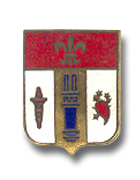 194th Field Artillery Bn DI 194th Field Artillery Bn DI |
|||||||
| (Source: 142nd Field Artillery Group, Germany, 1954) | |||||||
| History of the 194th Field Artillery Battalion The 194th Field Artillery Battalion was organized in November 1947 in Northwestern Iowa, as a National Guard Battalion, attached to the Iowa 34th National Guard Division. Shortly after the outbreak of hostilities in Korea, the unit intensified its training, and was ordered to active duty on 11 September 1950. The first duty station for the 194th was Camp McCoy, Wisconsin, where it received fillers and trained for a combat mission. In August of 1951, the 194th was alerted for overseas movement, and arrived in Germany in September of that year. The first duty station in Europe was in Northern Kaserne, at Wuerzburg, Germany, where the unit became a member of the combined arms team, organized to prevent further spread of Communism in the European family of nations. In September of 1952, the 194th was moved to its present duty station at Wertheim, Germany, with no change in its primary mission. The start of the year 1953 found the 194th Field Artillery Battalion at home station busy with normal garrison duties and class room training. The month of January was highlighted by the transfer of the Battalion, for Tactical Control, from the 30th Field Artillery Group, to the 142nd Field Artillery Group; and the Battalion's first exchange of Allied officers took place with the British Army. The Battalion received an overall rating of excellent in its annual IG inspection conducted in May, and twice the Battalion was given an overall rating of superior in CMI Inspections conducted by V Corps. The Battalion ended the year 1953 and entered the current one with the command and troops looking back on a year filled with sound, logical training, and knowing they were able to perform their tactical mission. For the men of the 194th, successful completion of the V Corps conducted Battalion test in August at Grafenwoehr, border patrol at Bamberg both in April and September, and an intensive program of garrison training and preparedness have constituted the salient events and activities of 1954. |
|||||||
| 1954 | |||||||
| (Source: Email from Paul R. Hollrah) | |||||||
| After seeing the Brad Pitt movie, “Fury,” I decided it was time to read a bit about the history of my old artillery units, the 194th Field Artillery Battalion, and its successor, the 254th Field Artillery Battalion. I was drafted in early August, 1953, and trained as a Field Artillery Operations and Intelligence Specialist at Camp Chaffee, Arkansas, from August 19 until December 19, 1953. Beginning our training with 222 men, all but three of us college-educated, we graduated 177 men on December 19, 1953. After a 15-day leave we arrived at Camp Kilmer, NJ on January 4, 1954 and sailed from New York on January 15 aboard the troop ship USNS Geiger. We arrived in Bremerhaven, Germany on January 25 and were sent by troop train to the U.S. Army Reception Center at Zweibrucken. We traveled five men to a compartment and it was quite a shock for us to see so much graffiti crudely sprayed on the sides of buildings reading, “Ami, Go Home!” and Yank, Go Home!” While at Zweibrucken, I was assigned to the 194th Field Artillery Battalion at Wertheim. I can’t recall exactly how many of us who trained together at Camp Chaffee were assigned to the 194th. I do recall that at least five of us were assigned to Able Battery, the first building on the right, inside the front gate, directly behind the base flagpole and directly across the street from the dependents’ quarters. And since Able Battery had only one of its two FDC positions open, Private Willis Cook of Wood River, Illinois was assigned VCO in A Battery FDC. Private John Clark was assigned to the Gun Section; Privates Don Jamerson, of Wood River, Illinois, and Lewis McQuaid, of Central Illinois, were assigned to the Wire Section (in the spring of 1954 Jamerson went on TDY as a member of the 142nd Field Artillery Group baseball team); Private Howard Glascock, of Hannibal, Missouri, was assigned as jeep driver for our Battery Commander, Captain Ramsey; and I was assigned as Assistant Forward Observer under Lieutenant John Willhauk, of St. Louis. Several months later, Corporal Martin Frost, Able Battery HCO rotated back to the States and I was assigned HCO duties in Able Battery FDC. Then, early in 1955, the 194th colors were rotated back to the states and we became the 254th Field Artillery Bn. During my 16 months as a member of the 194th and the 254th Field Artillery Battalions, we spent three FTXs at Grafenwoehr; one FTX at Baumholder, in the French Zone; one FTX at Bayreuth; and two stints on border patrol near Bamberg. It was in early May 1955 that the U.S. and Germany signed a new status of forces agreement. Prior to that signing, U.S. occupation forces were not held accountable for crimes under German law. Men who fathered children with German girls could not be held responsible. However, after the signing that was one of the things that changed. The only man in Able Battery who was caught in that net was our immediate superior, Master Sergeant J. D., a humorless, straight-faced Russian. Those of us rotating back to the states left Wertheim on May 15 and boarded the USNS General S.D. Sturgis, a World War II Liberty ship at Bremerhaven. I arrived back in New York on May 28, 1955, and was mustered out of military service at Fort Knox, Kentucky on June 4, 1955. |
|||||||
| (Source: Email from Jim Beilstein, 194th FA Bn) | |||||||
I was assigned to the 194th FAB in Aug 1954.. The Group was the 142nd.
Early in 1955 the unit designations were changed. 194th became the 254th and the 142nd became the 72nd.
I went to Fort Carson in April of 1956 as part of Operation Gyroscope.
I noticed a note from a musician who was a member of the 72nd Band. When I arrived in 1954 the Group had a drum and bugle corps of about 8 men that practiced about an hour a day in the afternoon and performed for ceremonies. The Group Commander was Col. Curtis and he was an old schooler and instituted a bugler of the Guard who played about two dozen calls a day from a microphone at the guard house. In November he got instruments and formed a band that also practiced for an hour each afternoon and evenutally played for ceremonies. It started with about a dozen members. In the summer Col Curtis sent the band to Nurenberg with the baseball team and liked the way we performed and put us on special duty in Sep. of 1955. A point of interest: The MSgt in charge of the bugle corps and the new band was a Sgt Miller. He was the first bugler to blow Call To Arms at Pearl Harbor and was in the Recruiting station in New Castle Pa which processed all the enlistees from that corner of PA. when I enlisted in 1949. |
|||||||
| 393rd FA Bn (155mm How)(SP) / 282nd FA Bn | |||||||
| 30th Field Artillery Group | |||||||
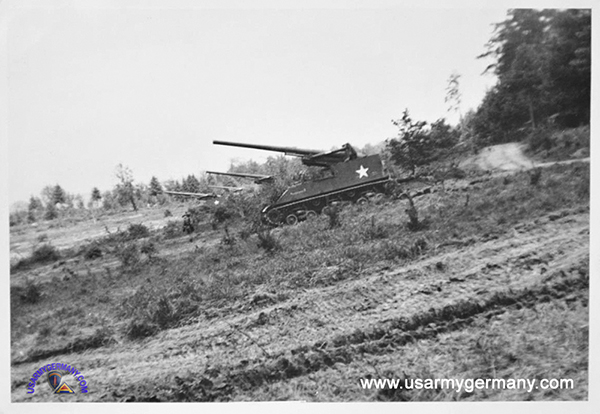 155mm self-propelled guns (M-40s) of the 393rd FA Battalion, 1952 |
|||||||
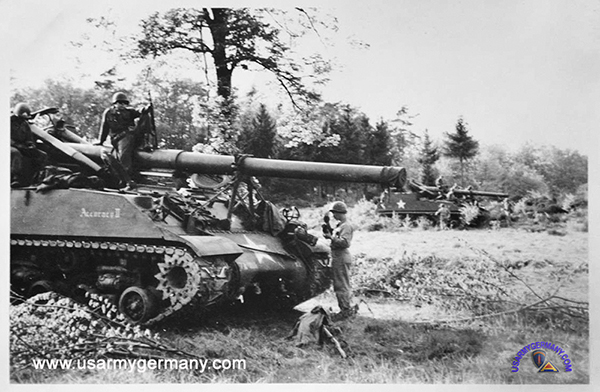 155mm self-propelled guns of Btry A, 393rd FA Battalion, 1952 |
|||||||
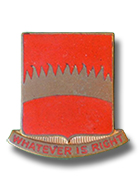 393rd Field Artillery Bn DI 393rd Field Artillery Bn DI |
|||||||
| 1951 | |||||||
| (Source: Email from Wesley E. Schissler) | |||||||
| I joined the 393rd FA Bn on December 4, 1949 in Lafayette, Indiana. I was a freshman at Purdue U. at that time. I was assigned to Service Battery, and Captain Fredrick Y. Reichart was my Commanding Officer. Lt Colonel Stephenson was the Battalion Commander.
In June of 1950 the Korean conflict broke out. In July President Harry Truman sent me a telegram indicating that Summer Camp was cancelled and we were ordered to report for active duty in Lafayette, Indiana on September 10, 1950. On January 4th or 5th the 393rd was transferred to Camp Polk, LA. Shortly after we reached Rucker I became the Battery Clerk of Service Battery and remained so the rest of my time on Active duty. At Camp Polk we began to acquire our equipment for the 3 gun batteries, mainly the 155mm self propelled gun. The other batteries in the Battalion were Headquarters and Service Batteries. We also acquired the rest of our TOE strength. I can remember traveling to Frankfurt to give General Eisenhower a roaring sendoff when to went to the States to run for President. We were activated for 21 month service and then extended to 24 months. Some of the fellows started going home at 20-21 months. I shipped back mid July 1952 on the General Patton, arriving at New Jersey a week later. I don’t know any history of the 393rd or how or when it was assign to Lafayette, IN. Cpl Wesley E. Schissler, Battery Clerk, 393rd FA Bn |
|||||||
| 1952 | |||||||
| (Source: Email from David Peterson, 393rd FA Bn, 1952-55) | |||||||
Just finished reading Clyde Titus's article. I was assigned to the 393rd FA Bn with the 142nd FA Gp at Neckarsulm, Germany. After we moved to Kitzingen, the unit became the 282nd FA Bn under the 30th Group. We kept the same shoulder heraldic device regardless of unit designation but I didn't see it displayed.
My time at the Artillery Kaserne goes back a little farther to the post war years 1952-1955. The building photos look the same as when I first was introduced to Germany. The 393rd BN and the 282BN of the 30th and the 142nd Field Artillery Group under the 7th U.S. Army were equipped with 155mm SP Guns. Our later move was to Kitzingen in an old former German Airfield. Really some good wine in Neckarsulm. After the Service time I worked for Douglas Aircraft Co. builder of the Honest John in R&D phases as well as all the Nike series, Ajax, Hercules and Anti-Missile Zeus while stationed at WSMR, New Mexico. I served 6 years in the Army and never got away from the Sevens. 7th Division in Japan and Korea and the 7th Army in Germany. The photo of the entrance to the now Hq, used to be our Mess Hall.
|
|||||||
| 142nd Field Artillery Group | |||||||
| 1954 | |||||||
| (Source: H Wayne Easter collection, Facebook) | |||||||
|
|||||||
| 1955 | |||||||
| (Source: STARS & STRIPES, Feb 4 1956) | |||||||
| The 393rd FA Battalion in Kitzingen, an Army Resrve unbit that was federalized in September 1950, was inactivated on January 7, 1955 and its colors returned to the US. The 282nd FA Battalion was activated on the same date, with no change in station. |
|||||||
| 1956 | |||||||
| (Source: STARS & STRIPES, Feb 4 1956) | |||||||
| The 282nd FA Bn at Kitzingen has been inactivated and some or all of its personnel have been reassigned to other artillery units: some to the 593rd FA Bn, others to the 288th AFA Bn. | |||||||
|
|
|||||||
| 631st AFA Bn (105mm How)(SP) / 290th AFA Bn | |||||||
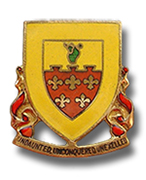 631st Armored Field Artillery Bn DUI 631st Armored Field Artillery Bn DUI |
|||||||
| 1951 | |||||||
| (Source: Email from Harvey Smith) | |||||||
I was stationed at Camp Clarke, Hammelburg, Germany from the summer of 1951 thru the fall of 1952. I was stationed with the 631st Armored Field Artillery (105 howitzers). The 631st came from Fort Sill, Okla & was a National Guard activated from Miss.
|
|||||||
| 1952 | |||||||
| (Source: Email from Jim Smith) | |||||||
| I was in A Btry, 631st AFA Bn (FDC Fire Direction Center) Oct 1952 to Mar 1954. This unit had the 155mm towed howitzer M114, 18 in all. The “AFA” in the unit
designation stands for “Armored Field Artillery”; towed 155mm are not “armored” -- by
no stretch of the imagination. The 631st was on a hill, Lager Hammelburg, overlooking the town of Hammelburg. There was a tank unit and displaced persons camp on the post with us. We where a V Corps unit and wore the Seventh Army patch. The unit got there about a year or so before I got there from Mississippi. The unit had had self propelled 155mm (might have been M44s) in Mississippi; this I was told by one of the few Mississippi old National Guard artilleryman who was still in Hammelburg. They were told “you will have self propelled weapons in Europe” which was not true. |
|||||||
| 756th FA Bn (8in, Hvy, How)(SP) | |||||||
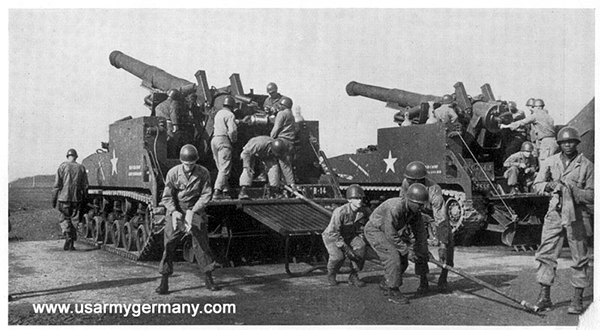 M-43 8in self-propelled howitzers of the 756th FA Battalion, 1954 |
|||||||
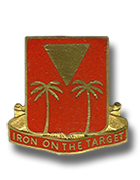 756th Field Artillery Bn DI 756th Field Artillery Bn DI |
|||||||
| 1953 | |||||||
| (Source: Email from Bill Good) | |||||||
| I want to respond to your page about 142nd Gp. USAREUR.
I was stationed at Peden Barracks in 1953-54 as a track vehicle mechanic. Actually, I was at Baumholder first for a short while, but assigned to C Btry, 756th FA Battalion (8in, Hv, SP). Moving to Wertheim was wonderful, as we had steam heat in Peden Barracks, and many of the facilities were new. The German people welcomed us with open arms and I made many friends there, as well as finding my wife there and we just this year celebrated our 50th anniv. We have been back to Germany several times in the years since 1970, but now all of my wife's family have passed on. Last year we did attend a wedding of a friends daughter and had a good time. I remember the 194th FA Battalion. They were nearby and had 155 howitzers (towed). We had 8-inch self-propelled, 4 to each btry. (A, B and C). Service Btry. had 5-ton Ints. and a VTR as well as a 5-ton wrecker. Each Btry. also had several 2 1/2 ton Reos. The other units as I remember at Peden were 557th Ambulance Co. and I think 142nd Gp. HQ. (Not sure about the number). Col. Pennel was Gp. commander and had survived the Bataan death march in WWII. We also had a sgt. who went through that and he and the Col. got together at times. I think that the "grasshopper" was for all the units at Wertheim, although we GIs didn't get to see much of it. Our Chaplain's asst. was in charge of the plane and must have been a liscensed A & E. I never knew who the pilot was. It would be great to have a roster of the men in 756th at about early 1953. My fellow mechanic who shared a semi-private room at the caserne, passed away a few years ago. Massive heart attack. I have been in contact with a few of my buddies from that time, but have no clue where most of them are now. Had intended to attend a reunion and was given a list of names, but none of them were familiar, except the btry commdr. and the exec officer. Wertheim is definitely different-no longer a US Army town and a real tourist trap. However, it still has a lot of charm and a lot of good memories for my wife and myself. Enjoyed reading your message on your website. |
|||||||
| Related Links: |
|||||||
